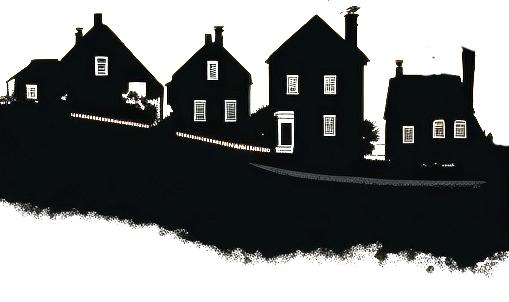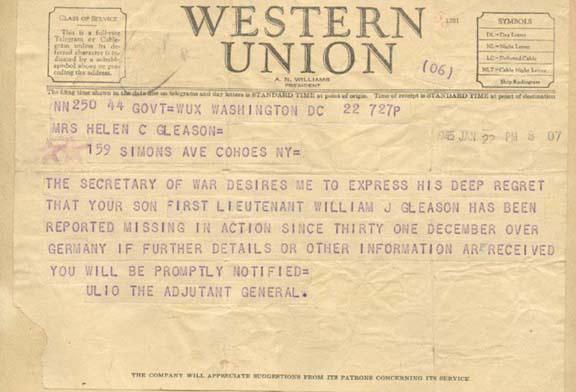

GLOSSARY
Based on the extensive dramaturgical work of SUSAN MYER SILTON
ANDY GUMP: the goofball main character in “The Gumps,” a daily newspaper cartoon strip that first appeared in 1917. It was created by Sidney Smith, first ran in the Chicago Tribune, became very popular right away, and was soon syndicated. Gus Edson inherited “The Gumps” in 1935 following the death of creator Sidney Smith, and continued with it until its final installment in 1959.
The 1940s strip, which pits Andy Gump against real-estate racketeers, would likely have been one that Frank read.
“The Gumps” Daily Comic Strip from the Chicago Tribune, 1940s, by Gus Edson.

ARMY AIR FORCE TRAINING COMMAND: The US Army Air Force trained its pilots during WWII at dozens of sites, due to the high demand for pilots when the War became imminent. The Army Air Forces Training Command (AAFTC), a unit that was inactivated after WWII, established centers in the US to train pilots, flying specialists, and combat crews. During its lifetime (January 23, 1942 to July 1, 1946), the command struggled with the challenge of a massive wartime expansion of the air forces. Wikipedia describes the extreme demand for flight personnel as well as aircraft and other equipment at that time, attesting to the pressure that Joe’s factory was under to produce:
Throughout 1942, the need for combat crew personnel far exceeded the current and contemplated production of the command’s flying training schools. The rate of expansion of housing and training facilities, instructors, as well as the procurement of aircraft and other equipment, though at a breakneck pace, constrained the rate of increase of production. Facilities were used to their maximum capacity as quickly as they could be stood up. Some schools were expanded while they were still under construction. New airfields had to be located in areas with sufficient flying space free of other air traffic, and the West Coast training center faced the extraordinary requirement to avoid sites near the internment camps for JapaneseAmericans.
Before WWII, the Army Air Corps had produced about 500 new pilots per year, which was adequate for the peacetime air corps. After the 1938 Munich Agreement, the number of pilots had to increase in case of a war breaking out again. As a result, a plan was developed to supplement the training at Randolph Field, Texas, where nearly all flying training took place, with military pilot training conducted at civil flight

schools in the United States.
In 1940, the War Department authorized the establishment of Air Corps enlisted replacement centers for the initial training of recruits. The Air Corps established the first of these centers at Jefferson Barracks, Missouri in the summer of 1940, though formal activation did not occur until February 1941. That fall, the Technical Training Command activated two more basic training centers at Keesler Field, Mississippi, and Sheppard Field, Texas, where the command already had mechanic schools.
By the time of the attack on Pearl Harbor, the Air Corps had 21,000 recruits at the three replacement training centers. The event made these three centers inadequate to supply recruits for technical training, so the number of basic training centers (BTC) expanded to 12 (plus one provisional center) by the spring of 1943. This included newly dedicated BTC facilities set up at Greensboro, North Carolina, Miami Beach and St Petersburg, Florida, and Atlantic City, New Jersey.
After the Japanese attack on Pearl Harbor and both Fascist Italy and Nazi Germany’s declaration of war against the United States in December 1941, plans were made by the Army to increase the training rate to 50,000, then 70,000 and finally 102,000 pilots per year. Civilian flying schools, under government contract, provided a considerable part of the flying training effort undertaken by the United States Army Air Forces. Dozens of Contract Flying Schools (CFSs) or Contract Pilot Schools (CPSs) were established under the Eastern, Western and Central Flying Training Commands. A list of them can be found here: https://en.wikipedia.org/wiki/ United_States_Army_Air_Forces_Contract_Flying_School_ Airfields
Clearly, there are any number of locations across the US where Chris could have trained, (best guess is George Army Airfield near Lawrenceville, Illinois) but what plane would he have been flying for his face to be visible in the cockpit? Trainers primarily used PT-17 Stearmans, aka the BoeingStearman Model 75, Ryan PT-22s, and Fairchild PT-19s, although a wide variety of other types could be found at the airfields.



WW2 U.S. propaganda poster: “O’er the ramparts we watch: United States Army Air Forces.”
BROADCLOTH: in contrast to the hair shirt, an expensive woolen or cotton fabric with a lustrous finish.
CYLINDER HEADS: the top of a cylinder encasing the valves and spark plugs in an internal combustion engine. A hole (or crack) in the cylinder head would lead to a lack of compression of fuel and air in the engine so combustion is compromised and the engine won’t start.
 The Ryan PT-22.
A Fairchild PT-19.
The Ryan PT-22.
A Fairchild PT-19.
DOLLAR
EQUIVALENCIES: The equivalent of $10 at the time of the play is now approximately $160.
DON AMECHE: Popular leading man of the 1930s-1940s.
DRAFT: the first peacetime draft in US history was held in 1940 for men ages 21 to 35, to serve one year. It was extended to 18 months of service in August 1941. After Pearl Harbor, Congress amended the draft law, removing restrictions and lengthening the term of service to the duration of the war plus six months and extending registration to all males between ages 18 and 65, with those between 20 and 45 eligible for the draft. More than 10 million men were drafted for World War II. Frank was always one year ahead of the draft, which Kate explains: “When they were calling boys twenty-seven Frank was twenty-eight, when they made it twenty-eight, he was just twenty-nine. That’s why he took up astrology. It’s all in when you were born, it just goes to show.”
GENERAL MOTORS: By 1947, GM had manufactured over 25 million cars and more than $12.3 billion worth of war material; one of the “big three automakers” along with Ford and DaimlerChrysler, GM was the size the Kellers could only dream of attaining, but clearly also means the Kellers are doing well.
HABERDASHERY AND THE PRESIDENCY: A haberdasher is a dealer in men’s clothing and accessories. Frank is referring to Harry S. Truman (1884-1972), who was the 33rd president of the United States, and the POTUS in the time the play is set. He was a haberdasher in the early 1920s.
Truman went from job to job before he opened his haberdashery. After high school graduation at the age of 17, he took a few odd jobs and eventually became a bank clerk. In 1906, he left the bank to help his father at the family farm. His father died, whereupon Harry invested in two risky endeavors in zinc and oil, both of which left him with more debt than before. He served as a captain in the army during WWI, and when he returned to the US, he decided to quit farming and instead set up a haberdashery in downtown Kansas City.
 Pictured left to right, in the Truman and Jacobson haberdashery ca. 1921, are Harry S. Truman, Francis Berry (a corporal in the 129th), Mike Flynn (a Lieutenant in Battery “D”), and Kelsey Cravens (a friend of Truman).
Pictured left to right, in the Truman and Jacobson haberdashery ca. 1921, are Harry S. Truman, Francis Berry (a corporal in the 129th), Mike Flynn (a Lieutenant in Battery “D”), and Kelsey Cravens (a friend of Truman).
HAIR SHIRT: a scratchy, uncomfortable shirt made of coarse animal hair, worn next to skin for as a selfimposed means of repentance and mortification of the flesh. It is often associated with martyrs, particularly from the various Christian traditions, and is worn during the Christian penitential season of Lent, especially on Ash Wednesday, Good Friday, and other Fridays of the Lenten season. Another name for a hair shirt is a cilice or sackcloth. Sackcloth and ashes were used in Old Testament times as a symbol of debasement, mourning, and/or repentance. Someone wanting to show his repentant heart would often wear sackcloth, sit in ashes, and put ashes on top of his head. Sackcloth was a coarse material usually made of black goat’s hair, making it quite uncomfortable to wear. The ashes signified desolation and ruin.

LABOR DAY / PLAYLAND: There were often kissing booths at Labor Day carnivals, and Playland was the name of some very famous amusement parks, which evolved to embrace all amusement parks. These also contained kissing booths.

MAHATMA GANDHI: (1869-1948)
political and spiritual leader of India, advocate of passive resistance. The honorific Mahātmā, which is Sanskrit for “high-souled” and “venerable,” was first bestowed on him in 1914 in South Africa and is now used worldwide. His full name is Mohandas Karamchand Gandhi.
P-40S: America’s foremost air “fighter” when WWII began. More than 14,000 P-40s had been produced for service at the height of WWII.

POLICE BADGES FROM THE POST TOASTIES BOXES: C.W. Post started his cereal company in 1894 in Battle Creek, Michigan. Post Toasties cereal was introduced in 1904; treats and toys in the box have been a marketing tactic since the early 1900s.

 Detective Badge Prize and Post Toasties Box, both ca. 1940s.
A hair shirt from the 19th century.
Detective Badge Prize and Post Toasties Box, both ca. 1940s.
A hair shirt from the 19th century.
TELEGRAMS: The military has specific procedures to notify the families of all ranks if a soldier or sailor is either killed, injured, or taken prisoner. It is usually done in person by an officer or two, accompanied by a chaplain. The visit is followed up by an official letter of acknowledgment, which would arrive later from the respective military service. During WWII, military offices were full of women who typed these form letters all day long.
During WWII, the Casualty Branch of the Army informed next of kin of casualties through telegrams. The availability of an officer to deliver the news had become scarce, as many were engaged in overseas warfare. Therefore, the military would send a special delivery telegram to the family notifying them of the death, injury, capture or disappearance, including the circumstances and location. Telegrams became the main vehicle for notification, and, instead of military personnel, were delivered by a Western Union messenger, the sight of whom was regarded with dread during WWII.

Telegram
ZEPPELIN:
 a rigid airship of a type originally manufactured by Luftschiffsbau-Zeppelin of Germany, consisting of a cigar-shaped, trussed, and covered frame supported by internal gas cells.
notifying the parents of First Lieutenant William Gleason that he was shot down on 12/31/44 over Germany. Kate and Joe would have received a similar telegram.
The Graf Zeppelin
a rigid airship of a type originally manufactured by Luftschiffsbau-Zeppelin of Germany, consisting of a cigar-shaped, trussed, and covered frame supported by internal gas cells.
notifying the parents of First Lieutenant William Gleason that he was shot down on 12/31/44 over Germany. Kate and Joe would have received a similar telegram.
The Graf Zeppelin
